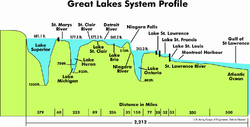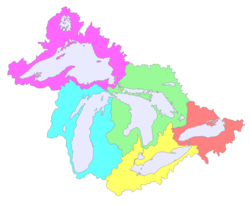Great Lakes
The Great Lakes are five large lakes in east-central North America. They hold 21% of the world's surface fresh water.[1]
The five lakes are: Lake Superior, Lake Michigan, Lake Huron, Lake Erie, and Lake Ontario.
Geography
Four of the Great Lakes are on the border between Canada and the United States of America. The other, Lake Michigan, is completely inside the United States.
All together, by volume, they are the largest group of fresh water lakes in the world. No one of the Lakes is larger than Lake Baikal (Russia) or Lake Tanganyika (East Africa).[2][3]
The cities of Chicago, Illinois (9.8 million people, on Lake Michigan), Toronto, Ontario (5.5 million, on Lake Ontario); Detroit, Michigan (5.3 million, on the Detroit river); Montreal, Quebec (3.9 million, on the St. Lawrence River), Cleveland, Ohio (2.9 million, on Lake Erie), Buffalo, and Ottawa (1.2 million, Ontario, on the Ottawa River) are on the shores of the Great Lakes or their rivers.
Though the five lakes have separate basins, they form a single, connected body of freshwater. The lakes connect the east-central interior of North America to the Atlantic Ocean. Lakes Michigan, Huron and Erie are approximately equally high and ships can easily pass from one to the next. Water flows from Lake Superior and Lake Michigan into Lake Huron; then through the Detroit River into Lake Erie; then through Niagara Falls into Lake Ontario; and then through the Saint Lawrence River to the Atlantic Ocean. Water also drains from the Chicago River on the south.[Note 1]
Many rivers flow through a large watershed into the lakes. The lakes have about 35,000 islands. The Great Lakes region includes the five lakes and many thousands of smaller lakes, often called inland lakes.
| Lake Erie | Lake Huron | Lake Michigan | Lake Ontario | Lake Superior | |
|---|---|---|---|---|---|
| Surface area[4] | 9,910 sq mi (25,700 km2) | 23,000 sq mi (60,000 km2) | 22,300 sq mi (58,000 km2) | 7,340 sq mi (19,000 km2) | 31,700 sq mi (82,000 km2) |
| Water volume[4] | 116 cu mi (480 km3) | 850 cu mi (3,500 km3) | 1,180 cu mi (4,900 km3) | 393 cu mi (1,640 km3) | 2,900 cu mi (12,000 km3) |
| Elevation[1] | 571 ft (174 m) | 577 ft (176 m) | 577 ft (176 m) | 246 ft (75 m) | 600 ft (180 m) |
| Average depth[5] | 62 ft (19 m) | 195 ft (59 m) | 279 ft (85 m) | 283 ft (86 m) | 483 ft (147 m) |
| Maximum depth | 210 ft (64 m) | 770 ft (230 m) | 923 ft (281 m) | 808 ft (246 m) | 1,332 ft (406 m) |
Lake Michigan and Lake Huron hit all-time record low levels in 2013.[6]
The unusual shape of the Great Lakes has created the possibility of large waves called seiche. If a storm causes a fast, strong increase in air pressure on one side of a lake, the water level on that side of the lake will drop and suddenly push up the water level on the opposite side of the lake. A 10 foot tall wave in Chicago caused several deaths in 1954.[7]
Ecological threats
The Great Lakes are home to a variety of species of fish and other organisms. In recent years, overfishing caused a decline in lake trout. The drop in lake trout increased the alewife population. In response, the government introduced salmon as a predator to decrease the alewife population. This program was so successful that the salmon population rose rapidly, and the states surrounding Lake Michigan promoted 'salmon snagging'. This has been made illegal in all of the Great Lakes states except for a limited season in Illinois. Lake Michigan is now being stocked with several species of fish. However, several invader species such as lampreys, round goby, and zebra mussels threaten the native fish populations.
Invasive species
Accidentally introduced species are a big problem. Since the 19th century about 160 species have invaded the Great Lakes ecosystem, causing severe economic and ecological impacts.[8] According to the Inland Seas Education Association, they deprive fish of food, cause blooms of toxic algae, and foul boats, spawning areas and drinking water intakes. On average a new invasive species enters the Great Lakes every eight months.[8]
Two important infestations in the Great Lakes are the zebra mussel, first discovered in 1988, and the quagga mussel in 1989. These molluscs are efficient filter feeders. They compete with native mussels, and also reduce available food and spawning grounds for fish.
Also, the mussels hurt utility and manufacturing industries by clogging or blocking pipes. The U.S. Fish and Wildlife Service estimates that the economic impact of the zebra mussel will be about $5 billion over the next decade.[9] Because the quagga mussel is good at filtering plankton from the lake water, sunlight reaches deeper into the lake. This increases the growth of algae.[10]
Pollution
Chemicals from industrial plants run off the land into rivers and arrive in the lakes. Some of these chemicals are highly toxic, such as mercury. Contaminated water from sewer overflows also reaches the lakes, and beaches get closed because of the threat of pathogenic bacteria.[8]
Great Lakes Media
Lake Michigan–Huron with north oriented to the right; taken on April 14, 2022, during Expedition 67 of the International Space Station. Green Bay is at the upper right and Saginaw Bay is on the left.
South Bass Island in Lake Erie
Toronto on Lake Ontario is in the eastern section of the Great Lakes Megalopolis
1675 French map, published shortly before the voyage of Le Griffon. Lake Michigan is named Lake Illinois (the name change is first recorded in 1681), and Lake Ontario is named Lake Frontenac, after the then-governor of New France.
Lakes Superior, Michigan, Huron, and Erie, photographed from the Sentinel-3B satellite in June 2022, Lake Ontario is not visible in this image.
Notes
- ↑ The Chicago River originally flowed into Lake Michigan. The flow was artificially reversed to protect the quality of Chicago's drinking water that comes from Lake Michigan.
References
- ↑ 1.0 1.1 "Great Lakes – U.S. EPA". Epa.gov. 2006-06-28. Retrieved 2011-02-19. Note: by 'surface' is meant 'as measured by surface area'. Measured by volume it would no doubt be a lesser figure.
- ↑ "LUHNA Chapter 6: Historical Landcover Changes in the Great Lakes Region". Biology.usgs.gov. 2003-11-20. Archived from the original on 2012-01-11. Retrieved 2011-02-19.
- ↑ Ghassemi, Fereidoun (2007). Inter-basin water transfer. Cambridge, Cambridge University Press. ISBN 978-0-52-186969-0.
- ↑ 4.0 4.1 "Great Lakes: Basic Information: Physical Facts". U.S. Government. May 25, 2011. Retrieved November 9, 2011.
- ↑ Grady, Wayne (2007). The Great Lakes. Vancouver: Greystone Books and David Suzuki Foundation. pp. 42–43. ISBN 978-1-553-651970.
- ↑ Lakes Michigan, Huron hit record low water level Feb. 5, 2013
- ↑ "Seiches". Retrieved November 24, 2011.
- ↑ 8.0 8.1 8.2 "Our threatened Great Lakes". Inland Seas Education Association. Archived from the original on 2013-04-03. Retrieved 2007-11-30.
- ↑ "Great Lakes aquatic nuisance species". Great Lakes Commission. 2007-03-27. Retrieved 2007-11-30.
- ↑ "Tiny mussels invade Great Lakes, threaten fishing industry". PBS Newshour. November 23, 2011. https://www.pbs.org/newshour/bb/environment/july-dec11/mussels_11-23.html#transcript. Retrieved November 23, 2011.











